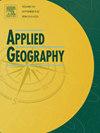Exploring the relationship between city size and carbon emissions: An integrated population-land framework
IF 4
2区 地球科学
Q1 GEOGRAPHY
引用次数: 0
Abstract
As global climate change intensifies and urbanization accelerates, research on urban climate change has become a global concern. Urban decision-makers must determine optimal city sizes to achieve net-zero emissions. However, previous studies have mainly focused on average relationships between city size and carbon emissions, overlooking non-linear dynamics. This study used urban scaling laws to investigate relationships between city size and carbon emissions from population and land perspective across 294 Chinese cities. Results showed a sub-linear relationship between urban population size (UPS) and carbon emissions and a super-linear relationship between urban land size (ULS) and carbon emissions. Regionally, cities in central regions demonstrated higher carbon emission performance than those in western and eastern regions. The land perspective indicated lower carbon emission performance compared to the population perspective. Both perspectives revealed non-linear relationships between city size and urban scaling exponent for carbon emissions, characterized by multiple minima. Multiple city sizes can achieve optimal carbon emissions; however, only one ULS is ideal for a specific city size to ensure environmental sustainability. This study provides valuable policy insights for decision-makers in formulating reasonable low-carbon strategies.
城市规模与碳排放的关系研究:人口-土地一体化框架
随着全球气候变化加剧和城市化进程加快,城市气候变化研究已成为全球关注的热点。城市决策者必须确定实现净零排放的最佳城市规模。然而,以往的研究主要集中在城市规模与碳排放之间的平均关系上,忽视了非线性动态。本研究采用城市尺度法,从人口和土地的角度考察了中国294个城市的城市规模与碳排放的关系。结果表明,城市人口规模与碳排放呈亚线性关系,城市土地面积与碳排放呈超线性关系。从区域上看,中部城市的碳排放绩效高于西部和东部地区。与人口视角相比,土地视角的碳排放表现较低。两种观点都揭示了城市规模与城市碳排放尺度指数之间的非线性关系,并表现为多重极小值。多种城市规模可以实现最优碳排放;然而,对于特定的城市规模,只有一种ULS是理想的,以确保环境的可持续性。本研究为决策者制定合理的低碳战略提供了有价值的政策见解。
本文章由计算机程序翻译,如有差异,请以英文原文为准。
求助全文
约1分钟内获得全文
求助全文
来源期刊

Applied Geography
GEOGRAPHY-
CiteScore
8.00
自引率
2.00%
发文量
134
期刊介绍:
Applied Geography is a journal devoted to the publication of research which utilizes geographic approaches (human, physical, nature-society and GIScience) to resolve human problems that have a spatial dimension. These problems may be related to the assessment, management and allocation of the world physical and/or human resources. The underlying rationale of the journal is that only through a clear understanding of the relevant societal, physical, and coupled natural-humans systems can we resolve such problems. Papers are invited on any theme involving the application of geographical theory and methodology in the resolution of human problems.
 求助内容:
求助内容: 应助结果提醒方式:
应助结果提醒方式:


